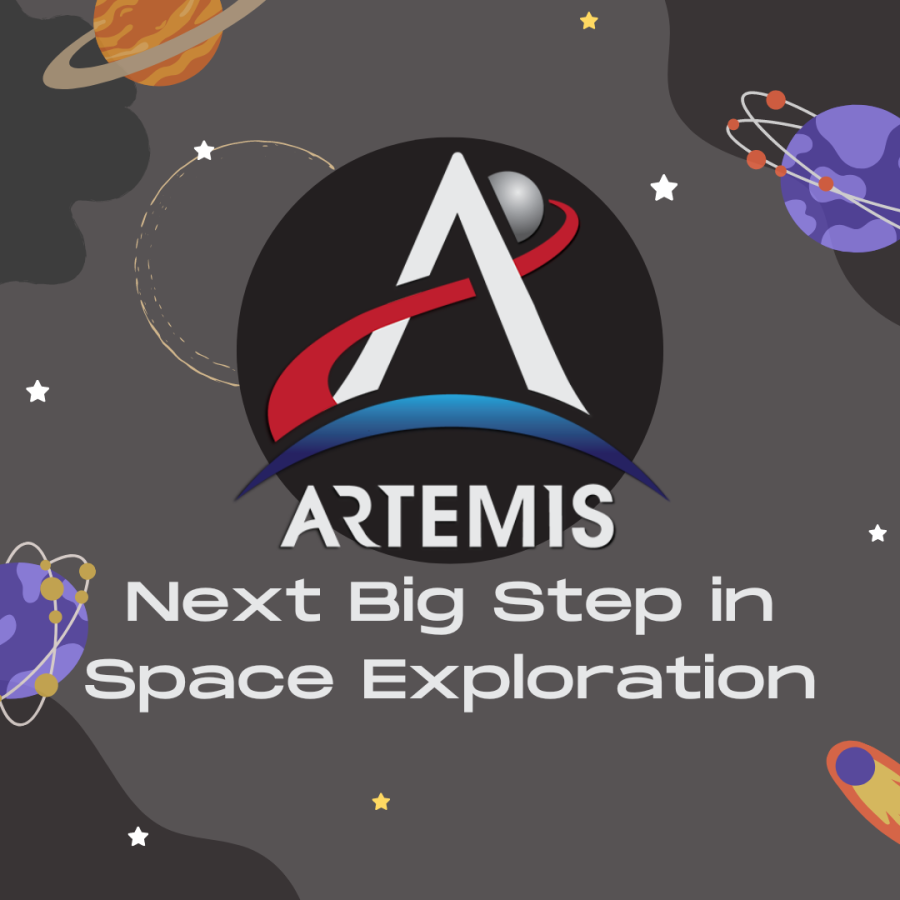NASA’S ARTEMIS MISSION
The Next Big Step in Space Exploration
We belong to one planet among billions.The vast array of twinkling lights in the night sky has driven human ingenuity since the beginning of civilization, and has led us to discoveries and technological revolutions previously unimaginable. We have now sent life beyond our atmosphere and robotic probes past the boundaries of our solar system, all driven by the human desire to know what else is out there.
The Artemis mission is the next major step in space exploration and will return humans to the moon while paving the way to Mars. Not only will the mission lead to new discoveries, but it will provide our generation and those who come after us with more opportunities to go into space than humanity has ever seen before.
What is Artemis and How Does it Work?
The last time humanity set foot on another celestial body was for the Apollo 17 mission in 1972. Now—after more than 50 years—we are finally on our way back. NASA’s Artemis aims to return humans to the moon, set up a permanent camp on the lunar surface, and place a space station into lunar orbit. Through Artemis, NASA will land the first woman and the first person of color on the moon and create opportunities for more people to explore space in the future. Artemis is a pioneer mission to develop colonies deeper into the solar system, and Generation Z will be some of the first to benefit from these opportunities. The mission officially began late last year and will continue on until at least 2025. Similar to the Apollo missions, Artemis will occur in phases, consisting of Artemis I, Artemis II, and Artemis III.
Artemis I accomplished its mission when the Orion capsule splashed down on 12/11/22, and has given us vital data needed to carry out the next stages of the program. It was an uncrewed mission intended to test the workings of the spacecraft beyond low earth orbit to ensure everything was functioning properly before sending astronauts along for the ride. Think of Artemis I as a test run for the rocket and Orion; a test that has been passed with flying colors. Artemis I proved the efficiency of the entire system and has given us the assurance that it is safe to move on to Artemis II. The vehicle designed for Artemis consists of the Space Launch System (SLS) rocket and the Orion capsule. The SLS is NASA’s most powerful rocket ever and is currently the only rocket capable of taking humans to the moon and beyond.The astronauts and additional payload will be in the Orion capsule atop the SLS, where they will ride safely and comfortably for future missions.
Stage two of Artemis will be a crewed flight of four astronauts first into Earth orbit, then beyond the moon. Recently, NASA announced the members of the Artemis II crew: Commander Reid Wiseman, Pilot Victor Glover, and mission specialists Christina Hammock Koch and Jeremy Hansen. The Orion capsule will launch atop the SLS, make two full Earth orbits, then slingshot itself a few thousand miles beyond the moon, only to be pulled back by Earth’s gravity. The team will not land on the moon for this mission, as its purpose is to test life support systems before embarking on a much longer trip to the lunar surface. Michael Serafin, the Artemis mission manager, explains that this stage is necessary because “This mission will prove Orion’s critical life support systems are ready to sustain our astronauts on longer duration missions ahead and allow the crew to practice operations essential to the success of Artemis III.” Artemis II is set to launch no sooner than 2024 and should take a total of 8 days to complete. This mission will send humans farther out into space than we have been before, yet another historical achievement of our species made possible through Artemis.
The third stage of Artemis will finally land us back on the moon. A crew of four astronauts will ride in the Orion capsule toward a lunar orbit. However, because Orion is not designed to touch down on the moon, NASA has chosen SpaceX to provide Artemis with a lunar lander. Once the Orion capsule has reached Lunar orbit, it will dock with SpaceX’s starship rocket, which will have been waiting for it in orbit, where two astronauts will board and two will remain in Orion. Starship will touch down on the Lunar South Pole—a region yet to be visited by humans—where the surface crew will conduct various research and explore the area in advanced space suits designed specifically for Artemis III. The surface crew will live in Starship while they wait for the Orion crew to complete one full orbit, which will take about 6.5 Earth days. Once the orbit is completed, Starship will launch from the surface and dock with Orion where the team will be reunited and begin their journey back home.
Following the first several crewed missions to the moon where astronauts will be staying in Starship, NASA plans to construct a base camp on the Lunar South Pole. This base camp will offer crew members better environments for research and considerably more comfort. Initially, the camp will be able to house four astronauts for up to a month at a time, but with every mission, the camp will grow and become more self-sustaining, preparing us for the future inhabitation of Mars. Although this camp seems small, it will be the very first human settlement beyond Earth, and will only set the foundation for larger, more complex colonies. Along with the lunar base camp, early crewed missions will focus on assembling a space station named Gateway, built through international partnerships with the ESA, JAXA, and CSA. Gateway will be placed in an elliptical orbit around the moon so that it comes fairly close to the lunar surface while also reaching relatively near to the Earth, making trips to or from either destination as convenient as possible. This new space station will be like a more advanced version of the ISS. It will provide a docking port for cargo deliveries or visiting spacecraft, additional living quarters, and another space for scientific research.
How Will Space Exploration Benefit Humanity?
When comparing how quickly we got to the moon during the Apollo era, it seems to be taking us much longer than it should to return, especially with today’s technology. This is mainly due to the difference in the US’ current political situation now compared to the 1960s and 70s. During Apollo, we were in the midst of an international space race; the US and Russia were feverishly trying to prove their technological superiority to the other. As you may imagine, this was quite the incentive to make NASA a funding priority. In fact, NASA’s budget peaked during the Apollo missions and hasn’t been as high since. The Artemis mission is different. This time we aren’t going to the moon to prove our political supremacy, we are going to the moon because of pure human desire for exploration and the prospect of scientific discovery. And unlike Apollo, we aren’t stopping at the moon this time. The Artemis mission marks the beginning of a new era in human space exploration, creating more jobs for astronauts by expanding our presence in space deeper into the solar system.
While this is undoubtedly an exciting time for space enthusiasts, there are plenty of people concerned about all the time and resources being devoted to space exploration that could potentially be used to solve problems we already have on our own planet. This unease surrounding costs of space exploration is a further difference in the political environment surrounding NASA now, compared to the space race era. Although many students here at iUP disagree and believe that space exploration is crucial as well as worth the cost, this concern is taking a toll on NASA’s capabilities. After all, Artemis’ total budget is a whopping $93 billion. Additionally, there are also those who don’t believe that launching humans into space is worth the risk when the job could be done just as efficiently by robots. Cost aside, humans require all kinds of life support equipment, are susceptible to error, and we would be putting their lives at risk. When asked of iUP students, 77% confidently agreed that crewed missions were worth the risk, while the remainder concluded that as long as the crew is safe and the mission benefits humanity, sending people to space on missions is worth it. Furthermore, crewed missions attract considerably more attention from the public than uncrewed ones, and inspire younger generations to develop an interest in STEM careers. Yes, $93 billion is a lot of money, but in comparison to other large areas of government spendings, it’s surprisingly small.
This year, NASA’s budget makes up only 0.4% of the US’ total annual spending. If we’re developing a colony over 200,000 miles away from our home planet and are regularly sending humans to a laboratory in space with just .4% of the country’s spending, imagine what we could be doing with 1%. iUP students have given their opinions on the importance of space exploration, and have settled on the conclusion that it is crucial to our species’ advancement.
While all students agreed on the importance of space programs, some had optimistic reasoning while others saw it more as a much-needed backup plan for when things on Earth go wrong. Student Danny Hall believes that “space exploration is important because there is just simply so much of the universe that humans know literally nothing about, and that even discovering little can advance humanity farther than anyone could imagine.” Other students are motivated by the fact that society’s ability to live on this planet responsibly isn’t exactly trustworthy. Caeden Conley thinks that “whether the reason is due to global warming or nuclear warfare, there need to be solutions for future generations to live on safely.”
As the survey has shown, what inspires our generation to explore outer space can vary greatly. Whether we shoot for the stars fueled by discovery, the prospect of human survival, or a combination of the two, we will change human history forever and create more opportunities for all to venture beyond our home planet. There is, without a doubt, no shortage of people who are more than willing to go to space, but because there isn’t a vast array of destinations prepared for human inhabitants beyond our planet, there is currently minimal room for astronauts. Today, the only place astronauts visit regularly is in Earth Orbit, and even there we don’t have much room in the space stations. This makes becoming an astronaut a very competitive pursuit and leaves thousands of dreamers unable to see the sublime beauty of space.
Artemis is building the foundation for space colonies and leading the way for a permanent human presence on other celestial bodies. With more destinations ready for human presence comes more opportunities to go into space. Having multiple laboratories and a greater variety of jobs means a more diverse range of professions will be needed in beyond-Earth research, and our generation will be the ones fit for the job by the time these destinations are up and running. All of this will lessen the competition to become an astronaut and will eventually lead to more opportunities for the general population to visit space. Furthermore, having an established base camp on the moon and/or Mars will lay the groundwork for other organizations to do the same (whether it be commercial or science-driven), resulting in an exponentially evolving extraterrestrial human presence.
Through Artemis and the missions that come after, we can advance human society, secure a safe future, and quite possibly make discoveries that we can’t even bring ourselves to conceive of today. Not only will space exploration advance human technology, but it will also inspire and unite people around the world to look beyond our national differences and small-scale disputes on Earth. If that isn’t a noble pursuit for humanity, then I don’t know what is.
Works Cited:
(2023)Your Guide to NASA’s Budget. The Planetary Society. Retrieved March 24, 2023, from
https://www.planetary.org/space-policy/nasa-budget
Warner,C.(2020, October 28). Lunar Living: NASA’s Artemis Base Camp Concept. NASA. Retrieved March 24,2023, from
https://blogs.nasa.gov/artemis/2020/10/28/lunar-living-nasas-artemis-base-camp-concept/
Harbaugh,J.(2022, July 29). Space Launch System. NASA. Retrieved March 24, 2023, from
https://www.nasa.gov/exploration/systems/sls/fs/sls.html
Hambleton,K.(2023, March 23). NASA’s Frist Flight With Crew Important Step on Long-term Return to the Moon, Missions to Mars. NASA. Retrieved March 24, 2023, from
Hambleton,K.(2023, January 25). Artemis I Overview. NASA. Retrieved March 24, 2023, from
https://www.nasa.gov/content/artemis-i-overview
Elburn,D. (2023, January 13). Artemis III: NASA’s Frist Human Mission to the Lunar South Pole. NASA. Retrieved March 24, 2023, from
https://www.nasa.gov/feature/artemis-iii
(2023, April 5). Our Artemis Crew. NASA. Retrieved April 9, 2023, from https://www.nasa.gov/specials/artemis-ii/

My name is Persephone Battle, I am a staff writer, and this is my second year with iHoot. I am now in 10th grade and have been with iUP since 5th. I think...

My name is Curtis Bamber, and I’m a sophomore here at iUniversity Prep. This is my 4th year here at iUp and iHoot and this year I will be your Co-Associate...
















